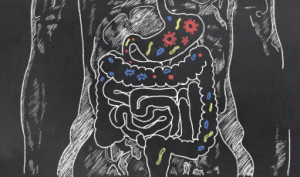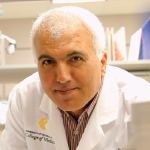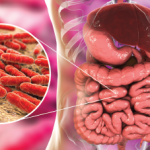
T. L. Furrer / shutterstock.com
Patients with a specific genetic predisposition for rheumatoid arthritis (RA) may want to take precautions when consuming certain types of meat, dairy and produce grown with cow manure, according to a new study out of the University of Central Florida (UCF) in Orlando.
The study, which assessed 100 RA patients, published in the journal Frontiers in Cellular and Infection Microbiology in January, linked the presence of the bacteria Mycobacterium avium subspecies paratuberculosis (MAP) with triggering RA in patients who have a mutation in the genes PTPN2 and 22, genes that regulate T cells.1 MAP belongs to a family of bacteria that includes leprosy and tuberculosis (TB) and remains difficult to treat.
The typical onset for RA in the 1.3 million adults in the U.S. who have it ranges from 40–60 years old. Three times as many women have it as men.
Lead researcher Saleh A. Naser, PhD, professor and associate director of the Burnett School of Biomedical Sciences at UCF, says the majority of rheumatoid arthritis patients—78% of those studied—have those genetic mutations, and when they are present, there’s a greater chance of finding MAP in the bloodstream.
T Cell Regulation

Dr. Naser
“The function of those T cells is to keep an eye on who comes and who goes,” Dr. Naser says. “They alert the immune system to take measures and respond to clear the invading pathogenic bacteria.” If there’s a mutation in those genes, however, the protein they make is no longer functional, and those immune cells can’t turn off the switch when the pathogen is gone, which results in further inflammation.
“MAP keeps the immune system on alert,” Dr. Naser says. “If someone has both the genetic mutation and MAP bacteria in their system, that will mean bad news to the patient, who will experience severe inflammation symptoms.” MAP not only flips the switch to turn RA on in predisposed patients, its presence in the bloodstream can make inflammation symptoms worse in patients already diagnosed with RA.
It’s estimated that more than 50% of dairy farms in the U.S. are contaminated with MAP, and more than 90% of dairy herds may be affected, although cattle may not show outward signs of infection.2 A potentially fatal disease in animals worldwide, MAP has been implicated in Johne’s disease, found in ruminants that include cattle, sheep and goats. The bacteria inflames the lining of the animal’s bowel and severely damages the gastrointestinal tract so nutrients cannot be absorbed. Milk production falls off, and the animal deteriorates and may die without treatment.3

Dr. Bég
“It lives in the gut of almost 90% of cattle in the United States,” says rheumatologist Shazia Bég, MD, an assistant professor of rheumatology at the UCF College of Medicine, and study co-author. “MAP can lead to a systemic infection with manifestations very similar to Crohn’s disease.” Studies have linked both Johne’s and Crohn’s disease to MAP infections.
Fascinated that many autoimmune diseases, from Crohn’s to multiple sclerosis to RA, share the common symptom of severe inflammation (albeit in different parts of the body), as well as nearly the same currently approved biologic treatment, Dr. Naser became curious about what else these diseases might have in common. He and his team partnered with Dr. Bég at the university’s medical school, and her patients participated in the study.
“In the last decade, Dr. Naser and his team had done quite a bit of research on Crohn’s disease and MAP and published very interesting findings that showed that compared to controls, a greater percentage of patients with Crohn’s disease and type 1 diabetes had serum cultures that were positive for MAP bacteria,” Dr. Bég says. “There’s a theory that’s been going around for the last decade that this MAP bacteria could be one of the causes for immune dysregulation, causing Crohn’s disease. We hypothesized that [because RA] is a systemic autoimmune disease with some joint manifestations similar to Crohn’s disease, perhaps MAP is also present more in [RA] patients through the same mechanisms.”
According to the study, 78% of the patients with RA were found to have a mutation in the PTPN2/22 gene, the same genetic mutation found in Crohn’s patients, and 40% of that number tested positive for MAP. Finding two mutated genes in both RA patients and Crohn’s patients confirmed Dr. Naser’s question as to why these two diseases share so much. “Finding the bacteria in the blood of [RA] patients was surprising and confirmed that these diseases not only share a genetic mutation, they also share an environmental trigger. We cannot change our genetic code, but we can do more to avoid environmental triggers.”
Researchers have studied identical-twin cases in which one has developed RA and the other has not. “This implies genes are not the only factor that cause RA. There can be many different things in the environment that might interact with genes and cause immune activation and lead to RA,” Dr. Bég says. “Smoking cigarettes has been proven to increase your risk for developing RA. The presence of MAP bacteria may be another risk factor.”
‘We should be aware of what we eat & how our food is processed, because there is growing evidence that bacteria present in foods may activate different autoimmune diseases.’ —Dr. Bég
MAP in Food
Special interest groups that promote plant-based diets and veganism have run with the story since the research was published as confirmation to avoid beef and its byproducts to remain healthy. But Dr. Bég, whose patients with RA volunteered to participate in the study and were tested for MAP, says this is just the beginning of testing their hypothesis.
“There are a lot of people who promote veganism, but I don’t want to imply that’s what we should do at this time,” she says. “First, MAP is not present in all dairy/beef products, and our study showed that mostly those patients who were both PTPN2/22 gene positive and MAP positive were the ones more likely to have [RA], again suggesting that it is the gene-environment interaction that leads to the cascade of immune activation. Second, this was a small sample size, [so] the findings have to be validated with larger studies.”
Meanwhile, Dr. Bég tells her patients RA is a very complex disease and there’s an interplay between a patient’s genetic makeup and the environment they inhabit. “Not everybody who is infected will get the disease. But we should be aware of what we eat and how our food is processed, because there is growing evidence that bacteria present in foods may activate different autoimmune diseases.”
Dr. Naser says it may prove sufficiently protective for those at risk of developing RA and those who already have RA to take food preparation and purchasing precautions with milk and meat. Produce grown with cow manure should be washed carefully before consumption. Dr. Naser recommends consuming ultra-pasteurized milk, which is heated at higher temperatures than normal pasteurized milk (280ºF or more for at least two seconds) and packaged under near sterile conditions. And meat, including goat, sheep and lamb, in addition to beef, should be well cooked. “If you see blood in your steak, be assured MAP is alive!” he says.
Dr. Bég advises her patients to avoid processed foods and to eat food grown organically and local, if possible.
The patients studied were asked to recall and write down how often they eat meat, fruits and vegetables so the researchers can look at whether there’s a higher correlation between which foods they’re eating and whether they have MAP. “So far we have not found a correlation,” Dr. Bég says, “but getting a diet diary is very hard. People don’t always remember what they eat.” Further studies are needed in this area.
Dr. Naser would like to see genetic testing after birth soon, so people can see which genes may be mutated and which diseases, such as Crohn’s and RA, may be triggered. “If you can adjust your lifestyle, food choices and avoid exposure to certain environmental triggers, you may prevent a lot of pain.”
MAP Antibiotics
The researchers also propose that if there is MAP bacteria in the blood, antibiotics should be considered in addition to the biologics or drugs the patient may already be taking for inflammation. “We hope to change the dogma and understanding,” Dr. Naser says. “We know antibiotics work on patients with Crohn’s disease.” Although some RA patients may also have Crohn’s and vice versa, the researchers say the evidence is anecdotal and a national study is needed to learn more about these patients.
Anti-MAP therapy requires strong antibiotics that include zythromax, clarithromycin (i.e., Biaxin) and refabutin, which also treat TB. Although MAP is in the TB-related family, it’s resistant to many TB drugs and therefore tougher to treat. “Biaxin and rifabutin, when given together, are usually effective in getting rid of MAP,” Dr. Naser says, adding that he does not see harm in adding antibiotics to a regimen for rheumatoid arthritis patients. “It’s a minimum of three months on the antibiotics,” he says. “When you read more about TB, you see patients are on this for a minimum of one year to clear the bacteria from their lungs. But with MAP, within three months patients are likely to see a difference in how they feel.”
According to Dr. Bég, the MAP/Crohn’s connection is strong, and there’s a website dedicated to creating a vaccine to protect against contracting MAP. Additionally, the antibiotic combination therapy RHB-104, developed by RedHill Biopharma, is an oral capsule with intracellular, antimycobacterial and anti-inflammatory properties that is currently in clinical trials to determine its effectiveness in eradicating MAP infection in patients with Crohn’s.
Although no commercial blood test is currently available to test humans for MAP, RedHill is developing one in collaboration with Quest Diagnostics. The UCF researchers analyzed blood serum and performed a polymerase chain reaction, which amplifies selected sections of DNA or RNA for analysis.
For the MAP/RA connection, however, more studies are needed. “We studied 100 patients and would like to expand our study to see if the numbers go up or down,” Dr. Naser says. As the first study to report anything like this with regard to RA, the researchers say their goal is to have this genetic mutation easily tested, as well as developing a way to prevent MAP with a vaccine and developing an effective antibacterial treatment for RA, in addition to immunosuppressant treatments.
Since the study has been published internationally, Dr. Bég says she is receiving emails from people asking if they can volunteer for studies. “Unfortunately, we’re not there yet to make it a multinational study, but our goal is maybe looking at different ethnicities and backgrounds to see if there’s a difference in MAP expression in people from different countries,” she says. “It’s all pretty exciting. Hopefully, we can keep doing the work we’re doing and find something here that will help our patients.”
Renée Bacher is a frequent contributor to ENT Today and the AARP Bulletin. Her article about heart disease in women, “This Story Could Save Your Life,” won a recent National Health Information Award for Family Circle magazine.
References
- Sharp RC, Bég SA, Naser SA. Polymorphisms in protein tyrosine phosphatase non-receptor type 2 and 22 (PTPN2/22) are linked to hyper-proliferative T-cells and susceptibility to Mycobacteria in rheumatoid arthritis. Front Cell Infect Microbiol. 2018 Jan 25;8:11. https://doi.org/10.3389/fcimb.2018.00011.
- Frie MC, Sporer KRB, Kirkpatrick BW, et al. T and B cell activation profiles from cows with and without Johne’s disease in response to in vitro stimulation with Mycobacterium avium subspecies paratuberculosis. Vet Immunol Immunopathol. 2017 Dec;193–194:50–56.
- Researcher finds possible link between cattle, human disease. WSU Insider. 2016 Nov 4.


